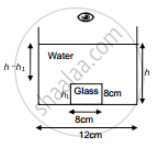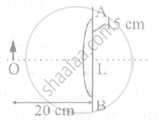Advertisements
Advertisements
प्रश्न
A cylindrical vessel of diameter 12 cm contains 800π cm3 of water. A cylindrical glass piece of diameter 8.0 cm and height 8.0 cm is placed in the vessel. If the bottom of the vessel under the glass piece is seen by the paraxial rays (see figure), locate its image. The index of refraction of glass is 1.50 and that of water is 1.33.

उत्तर
Given,
Diameter of the cylindrical vessel = 12 cm
∴ radius r = 6 cm
Diameter of the cylindrical glass piece = 8 cm
∴ radius r' = 4 cm and its height, h1 = 8 cm
Refractive index of glass, μg = 1.5
Refractive index of water, μw = 1.3
Let h be the final height of the water column.
The volume of the cylindrical water column after the glass piece is put will be:
\[\pi\] r2h = 800π +
\[\pi\] r'2h1
or r2h = 800 + r'2h1
or (6)2 h = 800 + (4)2 8
\[or `h = \frac{800 + 128} ( 36 ) = 928/36 = 25.7 cm`
There will be two shifts; due to the glass block as well as water:
\[∆ t_1 = \left[ 1 - \frac{1}{\mu_g} \right] t_g = \left[ 1 - \frac{1}{\frac{3}{2}} \right] \times 8 = 2 . 26 cm\]
\[ ∆ t_2 = \left[ 1 - \frac{1}{\mu_w} \right] t_w = \left[ 1 - \frac{1}{\frac{4}{3}} \right] \times \left( 25 . 7 - 8 \right) = 4 . 44 cm\]
Hence, the total shift = (Δt1+ Δt2) = (2.66 + 4.44) cm = 7.1 cm above the bottom.
APPEARS IN
संबंधित प्रश्न
Calculate the distance of an object of height h from a concave mirror of radius of curvature 20 cm, so as to obtain a real image of magnification 2. Find the location of the image also.
Use the mirror equation to show that an object placed between f and 2f of a concave mirror produces a real image beyond 2f.
Use the mirror equation to deduce that the virtual image produced by a convex mirror is always diminished in size and is located between the focus and the pole.
Use the mirror equation to show that an object placed between f and 2f of a concave mirror forms an image beyond 2f.
Use the mirror equation to show a convex mirror always produces a virtual image independent of the location of the object ?
A point source of light is placed in front of a plane mirror.
Mark the correct options.
A small object is placed at the centre of the bottom of a cylindrical vessel of radius 3 cm and height 4 cm filled completely with water. Consider the ray leaving the vessel through a corner. Suppose this ray and the ray along the axis of the vessel are used to trace the image. Find the apparent depth of the image and the ratio of real depth to the apparent depth under the assumptions taken. Refractive index of water = 1.33.
Write any one use for each of the following mirrors :
(a) Convex
(b) Concave
For paraxial rays, show that the focal length of a spherical mirror is one-half of its radius of curvature.
A point object is placed at a distance of 20 cm from a thin plano-convex lens of focal length 15 cm, if the plane surface is silvered. The image will form at:

The focal length f is related to the radius of curvature r of the spherical convex mirror by ______.
Car B overtakes car A at a relative speed of 40 ms-1. How fast will the image of car B appear to move in the mirror of focal length 10 cm fitted in car A, when car B is 1.9 m away from car A?
When a clock is viewed in a mirror, the needles exhibit a time which appears to be 8:20. Then the actual time will be:
A point object is placed at a distance of 30 cm from a convex mirror of a focal length of 30 cm. What is the separation between the image and the object?
